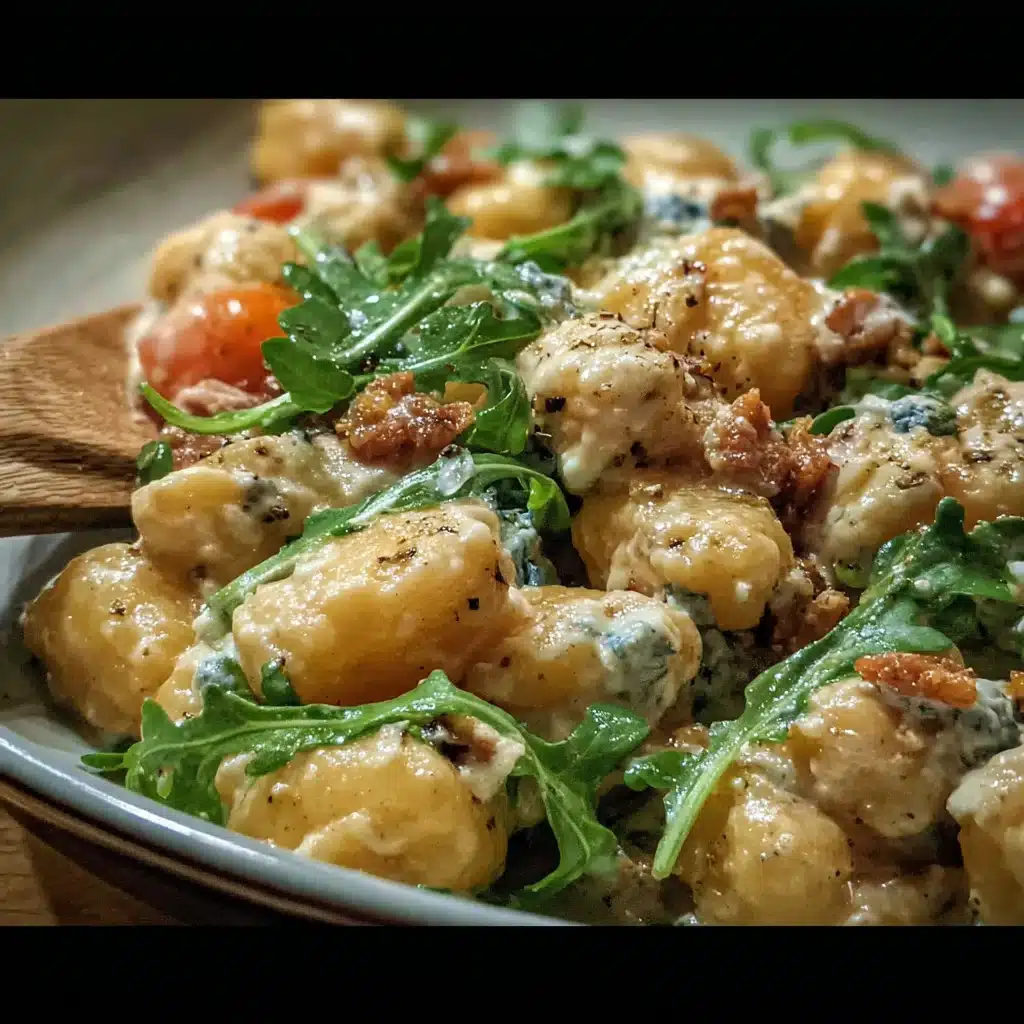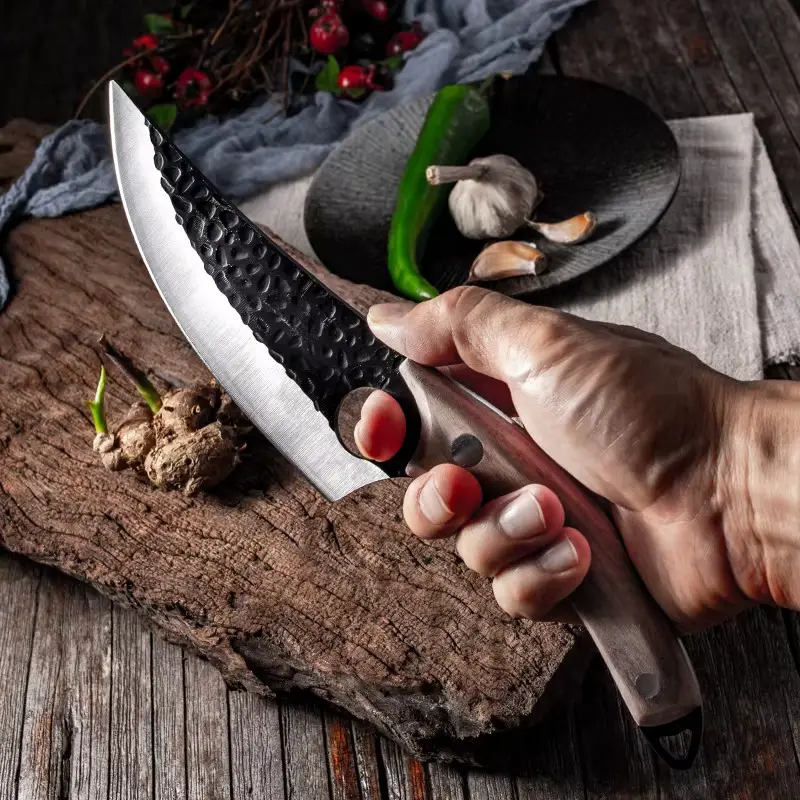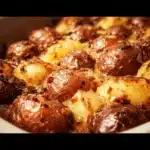There are meals that feed your body, and then there are meals that feed your soul. This Creamy Gorgonzola Gnocchi belongs firmly in the latter category. I’ll never forget the first time I made it. It was a chilly, rainy evening, the kind that calls for something deeply comforting. I had a package of potato gnocchi and a wedge of Gorgonzola in the fridge, and I decided to create something that would rival the rich pasta dishes from my favorite little Italian restaurant downtown. As the sauce came together, a magical aroma filled my kitchen—the pungent, earthy funk of the blue cheese melting into a velvety river of cream, all mingling with the scent of garlic and crispy sage. My expectations were high, but the first bite exceeded them all. The gnocchi were like little, tender pillows, and the sauce was an explosion of flavor—impossibly rich, sharp, savory, and so luxurious it felt almost sinful. It was a “close your eyes and savor the moment” kind of meal. Since that night, Gorgonzola Gnocchi has become my secret weapon. It’s the dish I make when I want to impress dinner guests with minimal effort, or when I simply need a twenty-minute escape to a trattoria in Northern Italy. It’s pure, unadulterated decadence in a bowl.
The Ultimate Gorgonzola Gnocchi Recipe
This recipe breaks down how to create a restaurant-quality Gorgonzola sauce that is perfectly balanced and clings beautifully to every single pillowy gnocchi. The key is in the quality of the ingredients and the technique for building the sauce.
Ingredients
- Potato Gnocchi: 1 pound (500 grams), store-bought or homemade. For the best results with store-bought, look for a vacuum-sealed, shelf-stable variety made with a high percentage of potato. These tend to have the best texture.
- Gorgonzola Cheese: 6 ounces (170 grams), crumbled. This is the star of the show. For a creamier, milder, and better-melting sauce, use Gorgonzola Dolce. For a sharper, more pungent, and intense blue cheese flavor, use Gorgonzola Piccante.
- Heavy Whipping Cream: 1.5 cups (360 ml). The high-fat content is essential for creating a stable, creamy sauce that won’t break or curdle when heated. Do not substitute with milk or half-and-half.
- Unsalted Butter: 2 tablespoons. This forms the rich base of our sauce.
- Fresh Sage Leaves: 10-12 large leaves. The earthy, slightly peppery flavor of fresh sage is a classic and essential pairing for the rich cheese.
- Garlic: 2 cloves, thinly sliced. It adds a gentle aromatic foundation without overpowering the cheese.
- Dry White Wine: 1/4 cup (60 ml), such as Pinot Grigio, Sauvignon Blanc, or an unoaked Chardonnay. This is optional but highly recommended for cutting through the richness and adding a layer of acidic complexity.
- Toasted Walnuts: 1/2 cup, roughly chopped. The crunchy texture and slightly bitter flavor of toasted walnuts provide the perfect contrast and balance to the creamy, rich sauce.
- Freshly Grated Parmesan Cheese: 1/4 cup (25 grams), plus more for serving. This adds a salty, nutty depth to the sauce.
- Freshly Ground Black Pepper: To taste. You likely won’t need much, if any, extra salt due to the saltiness of the cheeses.
- A Squeeze of Fresh Lemon Juice or a Pinch of Lemon Zest: (Optional Garnish) This is a secret weapon to brighten the final dish and keep it from feeling too heavy.
Step-by-Step Instructions for Perfect Gorgonzola Gnocchi
This dish comes together very quickly, so it’s best to have all your ingredients prepped and ready to go before you begin cooking (a process known as “mise en place”).
Step 1: Toast the Walnuts and Crisp the Sage
This initial step builds the crucial textural and aromatic elements of the dish.
- Toast the Walnuts: Place the chopped walnuts in a small, dry skillet over medium-low heat. Toast for 3-5 minutes, tossing frequently, until they are lightly browned and highly aromatic. Be very careful as they can burn quickly. Once toasted, immediately remove them from the pan and set them aside.
- Crisp the Sage: In a large skillet or pan (the one you’ll use for the sauce), melt the 2 tablespoons of unsalted butter over medium heat. Once the butter is melted and foaming, add the fresh sage leaves in a single layer. Fry for 1-2 minutes per side, until they become dark green, crisp, and fragrant.
- Set Aside: Using a slotted spoon, remove the crispy sage leaves from the pan and place them on a paper towel to drain. Leave the now beautifully sage-infused butter in the skillet.
Step 2: Build the Sauce Base
With the sage-infused butter as our starting point, we will now build the layers of flavor for the sauce.
- Sauté the Garlic: Add the thinly sliced garlic to the sage-infused butter in the skillet. Sauté over medium-low heat for about 60 seconds, or just until the garlic is fragrant. You want to soften it, not brown it, as browned garlic can become bitter.
- Deglaze the Pan: If using, pour in the dry white wine. Increase the heat slightly and let it bubble, using a wooden spoon to scrape up any flavorful bits stuck to the bottom of the pan. Allow the wine to reduce by about half, which should take about 2 minutes.
Step 3: Create the Creamy Gorgonzola Sauce
This is where the magic happens. The key here is low, gentle heat.
- Add the Cream: Lower the heat to low. Pour in the heavy cream and stir to combine with the contents of the pan. Let the cream warm through gently for 2-3 minutes. Do not let it come to a rolling boil.
- Melt the Cheeses: Add the crumbled Gorgonzola cheese and the grated Parmesan cheese to the warm cream. Stir gently and continuously with a whisk or wooden spoon until the cheeses have completely melted and the sauce is smooth and uniform.
- Season: Add a generous amount of freshly ground black pepper. Taste the sauce. It will likely be salty enough from the cheeses, but you can add a small pinch of salt if you feel it’s needed. Keep the sauce on the lowest possible heat while you cook the gnocchi.
Step 4: Cook the Gnocchi
Gnocchi cooks in the blink of an eye, so have everything ready.
- Boil Water: Bring a large pot of salted water to a rolling boil.
- Cook the Gnocchi: Add the gnocchi to the boiling water. They will sink to the bottom at first. Within 2-4 minutes, they will float to the surface. This is how you know they are cooked.
- Reserve Water and Drain: Just before draining, use a mug to reserve about 1 cup of the starchy cooking water. This water is “liquid gold” and is key to finishing the sauce. Drain the cooked gnocchi using a colander or slotted spoon.
Step 5: Combine and Finish the Dish
This final step brings everything together into a harmonious, perfect dish.
- Add Gnocchi to Sauce: Immediately transfer the hot, drained gnocchi directly into the skillet with the warm Gorgonzola sauce.
- Emulsify the Sauce: Gently toss the gnocchi to coat them in the sauce. If the sauce seems too thick, add a splash (about 1/4 cup) of the reserved starchy gnocchi water and stir. The starch in the water will help the sauce emulsify and cling perfectly to each gnocchi, creating a silky, non-greasy consistency. Add more water, a tablespoon at a time, until the sauce is your desired consistency.
- Serve Immediately: Divide the Gorgonzola Gnocchi among warm bowls. Garnish generously with the toasted walnuts and the crispy sage leaves. For a final touch of brightness, add a pinch of lemon zest or a very light squeeze of lemon juice over the top. Serve with extra grated Parmesan cheese on the side.
Nutrition Facts
- Servings: This recipe makes 2 large, indulgent main course servings or 4 smaller appetizer-sized portions.
- Calories per Serving: Approximately 850-950 kcal (for a main course serving).
- Disclaimer: This is a rich, decadent dish. The nutritional information provided is an estimate and will vary depending on the specific ingredients used, especially the type of gnocchi and cheese.
Preparation Time
- Active Preparation Time: 10 minutes
- Cook Time: 15 minutes
- Total Time: Approximately 25 minutes
How to Serve
While this Gorgonzola Gnocchi is a showstopper all on its own, pairing it thoughtfully can elevate the entire dining experience.
- Plating for a “Wow” Factor:
- Serve in wide, shallow bowls to showcase the dish.
- Spoon the gnocchi into the center, making sure plenty of the creamy sauce pools around it.
- Artfully crumble the crispy sage leaves over the top.
- Sprinkle generously with the toasted walnuts, ensuring they are evenly distributed for texture in every bite.
- Finish with a final grating of Parmesan cheese.
- Perfect Wine Pairings: The richness of the dish calls for a wine with good acidity to cut through it.
- White Wine: A crisp, dry Italian white like a Gavi or a Vermentino is perfect. A French Sauvignon Blanc from the Loire Valley would also be an excellent choice.
- Red Wine: If you prefer red, opt for something with bright acidity and not too much tannin. A Northern Italian red like a Barbera or a Dolcetto would be a fantastic match.
- Simple Side Salads: A simple, fresh salad is the ideal companion to balance the decadence of the gnocchi.
- Arugula Salad: A bed of peppery arugula tossed with a sharp lemon vinaigrette, shaved Parmesan, and perhaps a few pear slices.
- Simple Green Salad: Mixed greens with a simple balsamic vinaigrette to provide a tangy counterpoint.
- Bread for Dipping:
- Serve with slices of crusty, rustic bread like a ciabatta or baguette. It’s essential for soaking up every last drop of the incredible Gorgonzola sauce.
5 Additional Tips for Gnocchi Greatness
- The Gnocchi Water is Liquid Gold: I mentioned it in the recipe, but it bears repeating. Do not skip reserving the starchy water from cooking the gnocchi. It is the professional secret to a perfect pan sauce. The starches in the water help bind the fat (from the cream and cheese) and the liquid, creating a stable, silky emulsion that coats the gnocchi beautifully instead of separating.
- Low and Slow is the Motto for Dairy: The number one mistake when making cream or cheese sauces is using heat that is too high. High heat can cause the proteins in the dairy to tighten up and separate from the fat, resulting in a grainy or “split” sauce. Keep your burner on a low setting when the cream and cheese are in the pan, and never let it come to a rapid boil.
- Pan-Sear the Gnocchi for Extra Texture: For a delightful textural contrast, you can pan-sear the gnocchi before adding it to the sauce. After boiling and draining the gnocchi, pat them very dry. Add them to a hot skillet with a bit of butter or olive oil and cook for a couple of minutes per side, until they are golden brown and slightly crispy. Then, proceed with tossing them in the finished sauce.
- Balance the Richness: This is an intensely rich dish. The garnishes—walnuts and sage—are not just for looks; they are for balance. The earthy sage, the slightly bitter and crunchy walnuts, and the optional hit of acidic lemon at the end are all crucial for cutting through the fat and making the dish more complex and enjoyable. Don’t skip them!
- Choose Your Gorgonzola Wisely: The final flavor of your dish depends entirely on the cheese. Gorgonzola Dolce (meaning “sweet”) is younger, softer, and much creamier. It melts beautifully and provides a milder, more approachable blue cheese flavor. Gorgonzola Piccante (meaning “spicy” or “sharp”) is aged longer, is more firm and crumbly, and has a much more intense, pungent flavor. For most people, Dolce is the perfect choice for this sauce.
Frequently Asked Questions (FAQ)
1. My sauce seems grainy or separated. What did I do wrong and can I fix it?
This is almost always caused by the heat being too high when the cream and cheese were added. To fix a split sauce, remove the pan from the heat immediately. Try vigorously whisking in a tablespoon or two of cold heavy cream or a splash of the starchy gnocchi water. The combination of the whisking action and the temperature change can sometimes bring the emulsion back together. The key is to do this off the heat.
2. Can I use a different kind of cheese?
Yes, while Gorgonzola is classic, you can substitute other blue cheeses like French Roquefort (very sharp) or Danish Blue (creamy and milder). If you dislike blue cheese entirely, you could make a similar sauce using a good quality melting cheese like Fontina, Taleggio, or even a creamy goat cheese (chèvre), though the flavor profile will be completely different.
3. Can I add some vegetables or protein to this dish?
Certainly. This dish is a great base for additions.
- Vegetables: Sautéed mushrooms, wilted spinach, or tender-crisp asparagus spears would all be delicious. Add the spinach at the very end to wilt, or cook the other vegetables separately and stir them in.
- Protein: For a heartier meal, top the gnocchi with slices of grilled chicken or seared steak. Crispy, salty prosciutto or pancetta, crumbled over the top as a garnish, would also be a fantastic addition.
4. How do I store and reheat leftover Gorgonzola Gnocchi?
Store any leftovers in an airtight container in the refrigerator for up to 2 days. The sauce will thicken considerably when cold. The best way to reheat it is in a saucepan over low heat. Add a splash of milk or cream to the pan to help loosen the sauce as it warms up, stirring gently until the gnocchi is heated through. Avoid the microwave, as it can make the gnocchi rubbery and cause the sauce to separate.
5. Can I make the sauce ahead of time?
You can make the sauce a day in advance, but it will require careful reheating. Prepare the sauce up to the point before you add the gnocchi. Store it in an airtight container in the fridge. When you are ready to serve, gently reheat the sauce in a skillet over low heat, adding a splash of milk or cream to restore its smooth consistency. While the sauce is warming, cook your gnocchi fresh and then combine them as directed in the recipe.

Gorgonzola Gnocchi recipe
Ingredients
-
Potato Gnocchi: 1 pound (500 grams), store-bought or homemade. For the best results with store-bought, look for a vacuum-sealed, shelf-stable variety made with a high percentage of potato. These tend to have the best texture.
-
Gorgonzola Cheese: 6 ounces (170 grams), crumbled. This is the star of the show. For a creamier, milder, and better-melting sauce, use Gorgonzola Dolce. For a sharper, more pungent, and intense blue cheese flavor, use Gorgonzola Piccante.
-
Heavy Whipping Cream: 1.5 cups (360 ml). The high-fat content is essential for creating a stable, creamy sauce that won’t break or curdle when heated. Do not substitute with milk or half-and-half.
-
Unsalted Butter: 2 tablespoons. This forms the rich base of our sauce.
-
Fresh Sage Leaves: 10-12 large leaves. The earthy, slightly peppery flavor of fresh sage is a classic and essential pairing for the rich cheese.
-
Garlic: 2 cloves, thinly sliced. It adds a gentle aromatic foundation without overpowering the cheese.
-
Dry White Wine: 1/4 cup (60 ml), such as Pinot Grigio, Sauvignon Blanc, or an unoaked Chardonnay. This is optional but highly recommended for cutting through the richness and adding a layer of acidic complexity.
-
Toasted Walnuts: 1/2 cup, roughly chopped. The crunchy texture and slightly bitter flavor of toasted walnuts provide the perfect contrast and balance to the creamy, rich sauce.
-
Freshly Grated Parmesan Cheese: 1/4 cup (25 grams), plus more for serving. This adds a salty, nutty depth to the sauce.
-
Freshly Ground Black Pepper: To taste. You likely won’t need much, if any, extra salt due to the saltiness of the cheeses.
-
A Squeeze of Fresh Lemon Juice or a Pinch of Lemon Zest: (Optional Garnish) This is a secret weapon to brighten the final dish and keep it from feeling too heavy.
Instructions
Step 1: Toast the Walnuts and Crisp the Sage
This initial step builds the crucial textural and aromatic elements of the dish.
-
Toast the Walnuts: Place the chopped walnuts in a small, dry skillet over medium-low heat. Toast for 3-5 minutes, tossing frequently, until they are lightly browned and highly aromatic. Be very careful as they can burn quickly. Once toasted, immediately remove them from the pan and set them aside.
-
Crisp the Sage: In a large skillet or pan (the one you’ll use for the sauce), melt the 2 tablespoons of unsalted butter over medium heat. Once the butter is melted and foaming, add the fresh sage leaves in a single layer. Fry for 1-2 minutes per side, until they become dark green, crisp, and fragrant.
-
Set Aside: Using a slotted spoon, remove the crispy sage leaves from the pan and place them on a paper towel to drain. Leave the now beautifully sage-infused butter in the skillet.
Step 2: Build the Sauce Base
With the sage-infused butter as our starting point, we will now build the layers of flavor for the sauce.
-
Sauté the Garlic: Add the thinly sliced garlic to the sage-infused butter in the skillet. Sauté over medium-low heat for about 60 seconds, or just until the garlic is fragrant. You want to soften it, not brown it, as browned garlic can become bitter.
-
Deglaze the Pan: If using, pour in the dry white wine. Increase the heat slightly and let it bubble, using a wooden spoon to scrape up any flavorful bits stuck to the bottom of the pan. Allow the wine to reduce by about half, which should take about 2 minutes.
Step 3: Create the Creamy Gorgonzola Sauce
This is where the magic happens. The key here is low, gentle heat.
-
Add the Cream: Lower the heat to low. Pour in the heavy cream and stir to combine with the contents of the pan. Let the cream warm through gently for 2-3 minutes. Do not let it come to a rolling boil.
-
Melt the Cheeses: Add the crumbled Gorgonzola cheese and the grated Parmesan cheese to the warm cream. Stir gently and continuously with a whisk or wooden spoon until the cheeses have completely melted and the sauce is smooth and uniform.
-
Season: Add a generous amount of freshly ground black pepper. Taste the sauce. It will likely be salty enough from the cheeses, but you can add a small pinch of salt if you feel it’s needed. Keep the sauce on the lowest possible heat while you cook the gnocchi.
Step 4: Cook the Gnocchi
Gnocchi cooks in the blink of an eye, so have everything ready.
-
Boil Water: Bring a large pot of salted water to a rolling boil.
-
Cook the Gnocchi: Add the gnocchi to the boiling water. They will sink to the bottom at first. Within 2-4 minutes, they will float to the surface. This is how you know they are cooked.
-
Reserve Water and Drain: Just before draining, use a mug to reserve about 1 cup of the starchy cooking water. This water is “liquid gold” and is key to finishing the sauce. Drain the cooked gnocchi using a colander or slotted spoon.
Step 5: Combine and Finish the Dish
This final step brings everything together into a harmonious, perfect dish.
-
Add Gnocchi to Sauce: Immediately transfer the hot, drained gnocchi directly into the skillet with the warm Gorgonzola sauce.
-
Emulsify the Sauce: Gently toss the gnocchi to coat them in the sauce. If the sauce seems too thick, add a splash (about 1/4 cup) of the reserved starchy gnocchi water and stir. The starch in the water will help the sauce emulsify and cling perfectly to each gnocchi, creating a silky, non-greasy consistency. Add more water, a tablespoon at a time, until the sauce is your desired consistency.
-
Serve Immediately: Divide the Gorgonzola Gnocchi among warm bowls. Garnish generously with the toasted walnuts and the crispy sage leaves. For a final touch of brightness, add a pinch of lemon zest or a very light squeeze of lemon juice over the top. Serve with extra grated Parmesan cheese on the side.
Nutrition
- Serving Size: one normal portion
- Calories: 850-950 kcal





